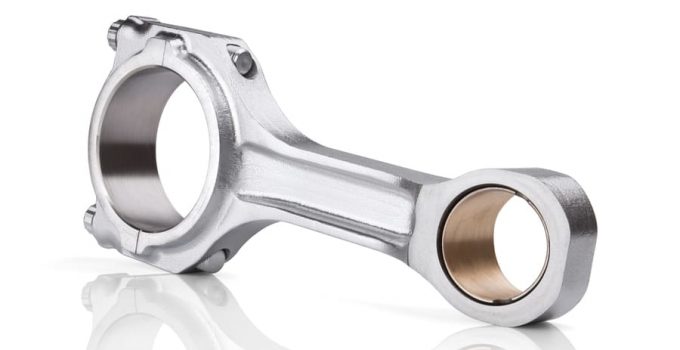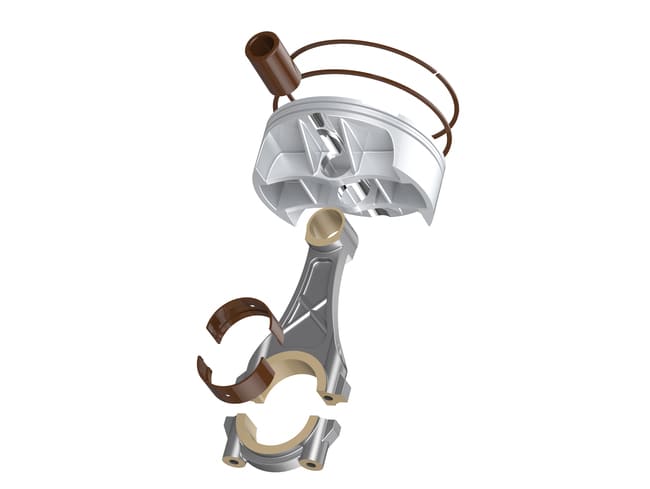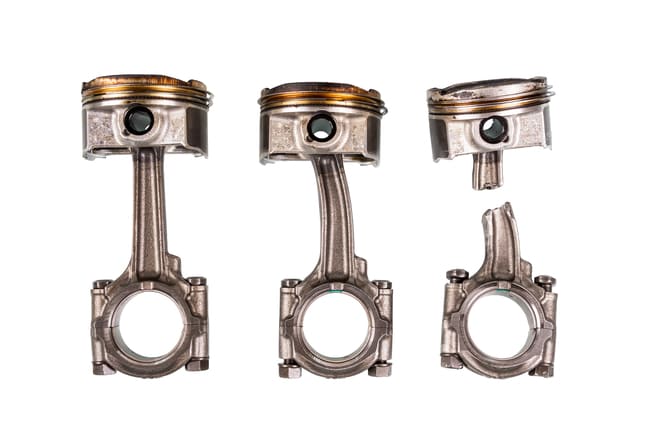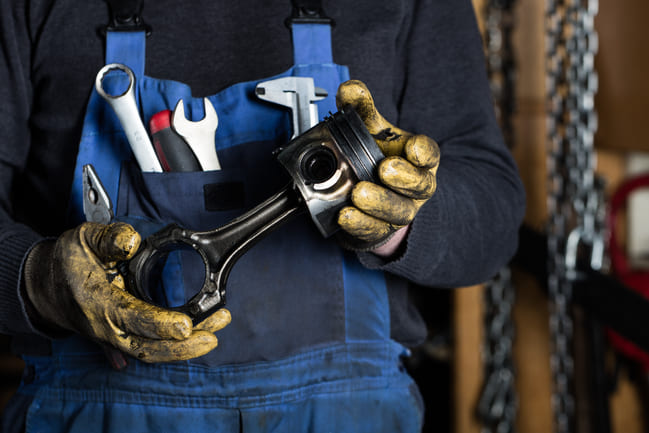
A connecting rod, also known as a connecting rod, is one of the most important components in the engine because it is responsible for power transmission in the vehicle train. Due to its function, the connecting rod is exposed to extremely high forces (tension/compression and bending/buckling), especially when increasing performance as part of engine tuning. Therefore, different types of connecting rods are available, each of which is designed for a special area of application and specific loads. Despite these extreme loads, defects and connecting rod bearing damage are rare in newer cars. Due to the high costs, however, it is not worth repairing newer cars. This is mainly an issue for the owners of vintage cars, whose engines are frequently repaired to keep their vintage status.
Contents
What is a connecting rod, how is it built and what is its function?

A fuel-air mixture is ignited in the cylinder chamber of a combustion engine, releasing energy in the form of gas forces. This causes the pistons to move (up and down). The connecting rod now has the function of a connecting piece between the pistons and the crankshaft. It converts the linear movement of the cylinders into a circular movement that drives the crankshaft, which then drives the camshaft via gears, toothed belts or a timing chain.
Connecting rods are usually made of C-70 steel, micro-alloyed steel, sintered metal, high-quality aluminum, heat-treated steel, carbon fiber reinforced plastic (CFRP) or titanium. The last three materials are mainly produced for the production of engines for sports cars, since here the connecting rods are subjected to significantly higher loads. In series production, connecting rods are usually forged, cast or sintered, while small quantities are machined from pieces of metal. The former is not suitable for use in engines with increased performance, as the load can quickly lead to a broken connecting rod.

The connecting rod consists of three interconnected parts, the small end, the connecting rod shank and the big end. The connecting rod head is mounted directly on the piston via the small connecting rod eye and is responsible for absorbing the stroke movement of the piston. The connecting rod shank serves as a connection between the connecting rod head and the connecting rod bottom and is often equipped with an oil duct to supply the small connecting rod eye with oil. The connecting rod foot then connects to the crankshaft through the large connecting rod eye in order to set it in motion.
There are different types of connecting rods that are suitable for different applications and requirements. A distinction is made here between the type of division and the separation process. Whether the connecting rods are divided straight or at an angle depends primarily on the size of the ball pivot. An oblique split is often useful with very large ball pins so that the large connecting rod eye of the connecting rod still fits through the cylinder bore, which is the case with diesel engines, for example. In the separation process, a distinction is made between cracking (breaking) and milling/grinding. For cracking, the connecting rods are made from one piece and provided with a break notch for later processing of the connecting rod or drilled at the later break point with the help of fine laser beams. During the subsequent assembly, the two parts are then screwed together, with the connecting rod and connecting rod cap sitting exactly on top of each other thanks to the break point. A cracked or broken connecting rod allows for better power transmission, higher strength, better manufacturing accuracy and lower cost. As an alternative to this, there is the option of sawing the large connecting rod eye apart and then milling or grinding it.
The connecting rod and crankshaft are connected to each other by the connecting rod bearings. These are designed as plain bearings that ensure an oil film between the connecting rod and the bearing so that they do not rub directly against each other. These bearings are particularly susceptible to damage and defects if they are not properly or insufficiently maintained.
Causes for a defective connecting-rod bearing

If the prescribed maintenance intervals and inspections, in particular changing the engine oil, are observed, the connecting rod bearings have a service life of at least 300,000 km. However, defects, wear and tear or damage to the connecting rod bearing cannot be completely ruled out and can have various reasons and causes:
- ! Material defects: Due to the extremely high load, material defects can lead to excessive wear of the connecting rod bearings and are more common in vintage cars
- !Insufficient lubrication of the connecting rod bearing due to too little oil, wrong oil, diluted or heavily contaminated oil, insufficient oil pressure: This can lead to the necessary oil film tearing and the bearing having direct contact with the crankshaft after a certain time due to the greater play , which can then also damage it, since without the lubricating film metal rubs against metal
- ! Long periods of vehicle inactivity: This can lead to the formation of corrosion on the bearing shells, causing it to fail when starting the Engine can be subject to severe abrasion and the connecting rod bearing or the crankshaft can be damaged
- !Overspeed due to vehicle operator error, i.e. when the driver accidentally shifts from third to second instead of fourth gear when quickly shifting a manual gearbox: In this case, not only the connecting rod bearings can be damaged, but also the connecting rods or the crankshaft
Symptoms of a defective connecting-rod bearing
A connecting rod bearing damage can be recognized very well by a clicking and knocking from the engine compartment when starting the engine, which then becomes louder and louder within a few seconds or minutes and with increasing speed and oil temperature. If you hear such noises, you should drive to a specialist workshop immediately and have your car examined. There, the experts with a practiced ear can quickly determine whether it is actually a question of connecting rod bearing damage or whether the noise is coming from defective valves or pistons that would make similar noises. However, you should not take such noises lightly, as connecting rod bearing damage in itself is not that bad. If the bearings are changed promptly, there is usually no consequential damage. However, if you drive a longer distance with damaged connecting rod bearings, the crankshaft and thus the entire engine can be damaged. Even if replacing the connecting rod bearing is expensive, complete engine damage is significantly more expensive.
Replacing a defective connecting rod bearing

Replacing a defective connecting rod bearing is always complex and very expensive. The material costs are limited, but since the engine has to be opened to change the connecting rods and/or the crankshaft, a visit to a specialist workshop is essential. Here the engine including all lines, connections and panels is first removed, then the connecting rod bearings and, if necessary, the crankshaft can be replaced with new parts. The bearings and the crankshaft must then be measured again to ensure that the axial and radial clearances are set correctly, since too little radial clearance can, for example, lead to the connecting rod bearing and crankshaft jamming, and too much to the oil pressure of the engine drops, which can quickly lead to renewed connecting rod bearing damage. Of course, once everything has been correctly adjusted and carefully checked, the previously dismantled parts must be reinstalled. This immense amount of work results in costs of around 1,500 to 6,000 euros for replacing a defective connecting rod bearing. However, as there are prepared replacement engines from 1,500 eurosthere is a tendency to replace the entire engine. Replacing the connecting rod bearings is therefore mainly useful for vintage cars, as they only retain their status as vintage cars if they only have original or original components, which is why a replacement engine would not be an option here.
<Conclusion
A connecting rod is one of the most important components of the engine, which is why damage must be repaired immediately or a defective connecting rod bearing replaced in order not to completely destroy the engine. However, this type of damage is rare in newer vehicles and is most often due to poor maintenance or operator error. However, replacing the connecting rod bearings is very time-consuming and expensive, since the entire engine has to be removed and opened for this. It is therefore advisable to replace the engine as a whole with a replacement engine. A repair or replacement of the individual connecting rod bearings is only worthwhile for very valuable cars, such as vintage cars. If in doubt, ask your trusted mechanic.
